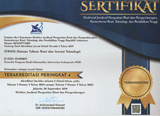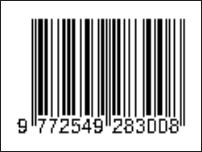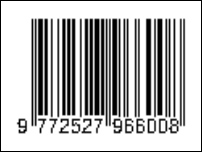Implementasi Digital Signature Pada Dokumen Elektronik Berbasis QR-Code
(1) Universitas Siliwangi
(2) Universitas Siliwangi
(3) Universitas Siliwangi
(*) Corresponding Author
Abstract
Documents can now be sent not only in paper form, but also in electronic form, making the distribution process faster. However, documents that require signature validation must be printed and signed conventionally before being sent. This conventional process is time-consuming and cannot be completed if the signer is not present. Balai Sertifikasi Elektronik (BSrE) which is under the auspices of Badan Siber dan Sandi Negara (BSSN) has an information system that implements the digital signature concept. However, this concept is limited to state administration institutions and has a closed source code, preventing it from being developed by the public. The aim of this research is to apply a QR Code-based digital signature system for signing electronic documents. The research method consists of problem identification, system architecture design, implementation, and testing. Based on the results of experiment, digital signatures using cryptographic techniques and QR Codes have been successfully applied in the process of signing electronic documents. Thus, the document signing process can be carried out without printing it first. Each QR-Code successfully embedded in an electronic document as a digital signature can store metadata: date, subject, name of signatory, position, institution or unit. Verification can be performed to ensure that the data stored behind the QR-Code is associated with a document that has been affixed with a digital signature.
Keywords
Full Text:
PDFReferences
N. Zaatsiyah and D. Djuniadi, Implementing Digital Signature With Rsa and Md5 in Securing E-Invoice Document, Cybersp. J. Pendidik. Teknol. Inf., vol. 5, no. 2, p. 129, 2021, doi: 10.22373/cj.v5i2.10359.
L. W. Untari and B. F. Tumanggor, Evaluasi Penerapan Aplikasi Naskah Dinas Elektronik (Nadine) Bagi Peningkatan Produktivitas Kerja Pegawai Di Biro Umum Sekretariat Jenderal Kementerian Energi Dan Sumber Daya Mineral, J. Sumber Daya Apar., vol. 4, no. 2, pp. 1126, 2022.
Y. B. Widodo, A. Anindya, and T. Sutabri, Pengembangan Aplikasi E-Reimbursement Karyawan Berbasis Android Pada PT Bringin Inti Teknologi, J. Teknol. Inform. dan Komput., vol. 7, no. 2, pp. 120131, 2021, doi: 10.37012/jtik.v7i2.644.
I. B. G. Sarasvananda and I. B. A. I. Iswara, Tanda Tangan Elektronik Menggunakan Algoritma Rivest Shamir Adleman (RSA) pada Sistem Informasi Surat Menyurat LPIK INSTIKI, J. Sisfokom (Sistem Inf. dan Komputer), vol. 11, no. 2, pp. 289296, 2022, doi: 10.32736/sisfokom.v11i2.1403.
E. K. Suni and H. I. Maulana, Penerapan Digital Signature Untuk Mengesahan Proposal Hibah Dikti Menggunakan Secure Hash Algorithm, JOINTECS (Journal Inf. Technol. Comput. Sci., vol. 5, no. 2, p. 105, 2020, doi: 10.31328/jointecs.v5i2.1318.
A. Nugraha and A. Mahardika, Penerapan Tanda Tangan Elektronik Pada Sistem Elektronik Pemerintahan Guna Mendukung E-Government, Semin. Nas. Sist. Inf. Indones., pp. 359364, 2016.
F. Nuraeni, H. Agustin, I. M. Muharam, T. Informatika, and T. Tasikmalaya, Implementasi Tanda Tangan Digital Menggunakan RSA dan SHA-512 Pada Proses Legalisasi Ijazah, Konf. Nas. Sist. Inf. 2018, pp. 864869, 2018.
B. R. Suteja, R. Imbar, and M. Johan, Implementation of QR Code on E-Certificate for Events at Maranatha Christian University, Conf. Senat. STT Adisutjipto Yogyakarta, vol. 5, pp. 401410, 2019, doi: 10.28989/senatik.v5i0.396.
E. Vasi Waruwu, Azanuddin, F. Sonata, and I. Zulkarnain, Penerapan Digital Signature Menggunakan Metode RSA Untuk Menvalidasi Keaslian Ijazah SMA Swasta Bina Artha, J-SISKO TECH J. Teknol. Sist. Inf. dan Sist. Komput. TGD, vol. 3, no. 2, pp. 4555, 2020.
B. K. Hutasuhut, S. Efendi, and Z. Situmorang, Digital Signature untuk Menjaga Keaslian Data dengan Algoritma MD5 dan Algoritma RSA, InfoTekJar (Jurnal Nas. Inform. dan Teknol. Jaringan), vol. 3, no. 2, pp. 164169, 2019, doi: 10.30743/infotekjar.v3i2.1019.
T. Yuniati and M. F. Sidiq, Legalitas Dokumen Elektronik Menggunakan Tanda Tangan Digita Sebagai Alternatif Pengesahan Dokumen di Masa Pandemi, J. Resti, vol. 4, no. 10, 2021.
Aswari and F. Suliantana, Penerapan Sistem Informasi Persuratan dengan Legalisasi Digital Signature di Universitas Pendidikan Indonesia, Syntax Idea, vol. 4, no. 12, pp. 17421753, 2022.
R. Kurniawan, R. F. Sari, and N. Azizah, Sistem Validasi Keaslian Dokumen Digital Berbasis QR-Code, J. Teknol. Inf., vol. 4, no. 2, pp. 321327, 2020, doi: 10.36294/jurti.v4i2.1722.
DOI: http://dx.doi.org/10.30998/string.v9i2.21407
Refbacks
- There are currently no refbacks.
Copyright (c) 2024 Rohmat Gunawan, Alam Rahmatulloh, Randi Rizal

This work is licensed under a Creative Commons Attribution 4.0 International License.
STRING (Satuan Tulisan Riset dan Inovasi Teknologi) indexed by:

Ciptaan disebarluaskan di bawah Lisensi Creative Commons Atribusi 4.0 Internasional.
View My Stats


 Sertifikat Akreditasi
Sertifikat Akreditasi
















